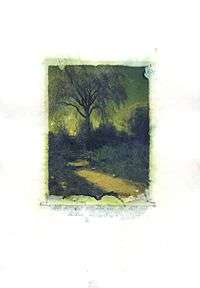Polaroid transfer
Polaroid transfer is a photographic image-transfer process, or print making technique, which uses Polaroid film. This way an image can be put on textiles, cups, glass and many other surfaces.
Process
Using a camera, enlarger, slide printer or Day Lab, expose Polaroid film. You need pull-apart type film, such as Polaroid 669 (now discontinued), or Fujifilm FP-100C (which is readily available). Develop by pulling the film from the holder. Wait about 10-15 seconds and quickly pull the film apart, not letting the two sides (the picture and the negative) touch. Put the pulled apart negative face down on paper (or other material). Place pressure over negative and let sit for about 20 minutes. Then pour hot water over each side of the negative/paper sandwich. Gently peel the negative from the paper. Allow transfer to dry, face up.
Slide printers allow you to make Polaroid transfers from previously-taken slides or negatives.

Tips
- Watercolor paper is generally a good paper to use for this process. You can use any paper surface, as well as other surfaces such as wood, cloth, ceramic, etc.
- Wet the paper with hot water prior to transferring, the paper should be damp and may need to be air dried or blotted with blotting paper.
- Bright light or sunlight can cause fading of transfer over time.
- Black and white Polaroid film should not be used.
- Film Types 669, 59, 559, and 809 can all be used.
See also
References
Further reading
- Polaroid Transfers by Kathleen Carr
- Polaroid Manipulations by Kathleen Carr
External links
- Photographer's Guide to Polaroid Transfer Step-By-Step by Christopher Grey
- Polaroid
- Polaroid Image Transfer Instructions
- Polaroid TV